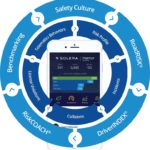Blog
Navigating Fleet Safety: The Impact of Distracted Driving and Solutions to Safeguard Your Fleet
Originally published in Fleet Management Weekly 5/1/24

By Sarah Bechtold, eDriving
May 1, 2024
In the ever-evolving landscape of fleet management, ensuring the safety of your drivers and vehicles is paramount. However, one of the most pervasive threats to fleet safety remains often overlooked: distracted driving. As Dr. Paul Atchley, Professor of Psychology at the University of South Florida and eDriving’s Brain Science Advisor, astutely notes in our Seven Stages of Distraction Denial eBook, “Most drivers think they are good drivers or at least better than average, which statistically cannot be true.” This inherent cognitive bias blinds many to their own “driving demons” and the potential risks posed by distracted driving.
 Driving is a multifaceted task that demands our full attention. The SPIDER model, as articulated by Strayer & Fisher (2016)*, underscores the complexity of safe driving, highlighting stages from scanning the environment for hazards to executing a safe response. Yet, the allure of multitasking, especially with the omnipresence of smartphones, poses a significant threat. Contrary to popular belief, our brains do not truly multitask; instead, they task-switch, leading to compromised attention and decreased driving performance.
Driving is a multifaceted task that demands our full attention. The SPIDER model, as articulated by Strayer & Fisher (2016)*, underscores the complexity of safe driving, highlighting stages from scanning the environment for hazards to executing a safe response. Yet, the allure of multitasking, especially with the omnipresence of smartphones, poses a significant threat. Contrary to popular belief, our brains do not truly multitask; instead, they task-switch, leading to compromised attention and decreased driving performance.
Consider the scenario of texting at stoplights. While seemingly innocuous, research reveals that it takes at least 27 seconds for attention to return to normal after engaging in such behavior**. This lapse in focus translates to a smaller scanning area and a diminished ability to identify hazards, particularly at intersections, the most perilous parts of the drive.
Even hands-free calls, often deemed safer alternatives, carry inherent risks. Studies show that conversing on a phone, whether handheld or hands-free, impairs driving performance nearly 82% of the time^, akin to the impairment caused by drunk driving. While passengers can also distract, they possess the advantage of shared situational awareness and the ability to modulate conversation, unlike phone calls.
 Despite advancements in vehicle technology, including driver assistance systems and enhanced safety features, fatalities on U.S. roads have been on the rise. This alarming trend underscores the need for proactive measures to combat distracted driving. Implementing policies that ban distracted driving, coupled with comprehensive education, monitoring, and enforcement, has proven effective in mitigating crash rates within fleet operations.
Despite advancements in vehicle technology, including driver assistance systems and enhanced safety features, fatalities on U.S. roads have been on the rise. This alarming trend underscores the need for proactive measures to combat distracted driving. Implementing policies that ban distracted driving, coupled with comprehensive education, monitoring, and enforcement, has proven effective in mitigating crash rates within fleet operations.
As fleet managers, it’s imperative to recognize the broader implications of distracted driving. Beyond endangering individual drivers, it exposes companies to substantial liability risks. A single crash while on company business can result in punitive damages amounting to millions, if not billions, of dollars. By prioritizing safety and instituting robust distracted driving policies, companies can safeguard their employees and assets while minimizing legal exposure.
Ultimately, addressing distracted driving requires a collective shift in mindset. Recognizing that 94% of crashes are caused by driver behavior^^ and attitude underscores the urgency of cultivating safer driving habits. Whether it’s for oneself, loved ones, or fellow road users, each moment spent free from distractions contributes to a safer driving environment.
 Combating distracted driving is not merely a matter of policy; it’s a moral imperative. By embracing a culture of safety and driver risk management programs such as Mentor by eDriving, fleet managers can protect their drivers, their businesses, and the communities they serve. As we navigate the road ahead, let us prioritize vigilance, responsibility, and the collective well-being of all road users.
Combating distracted driving is not merely a matter of policy; it’s a moral imperative. By embracing a culture of safety and driver risk management programs such as Mentor by eDriving, fleet managers can protect their drivers, their businesses, and the communities they serve. As we navigate the road ahead, let us prioritize vigilance, responsibility, and the collective well-being of all road users.
*Strayer, D. L., & Fisher, D. L. (2016). SPIDER: A Framework for Understanding Driver Distraction.
**Gross, A. (2020, November 4). New Hands-free Technologies Pose Hidden Dangers for Drivers.
^Atchley. (2017). Seven Stages of Distraction Denial.
^^National Highway Traffic Safety Administration. (2015). Critical Reasons for Crashes Investigated in the National Motor Vehicle Crash Causation Survey.